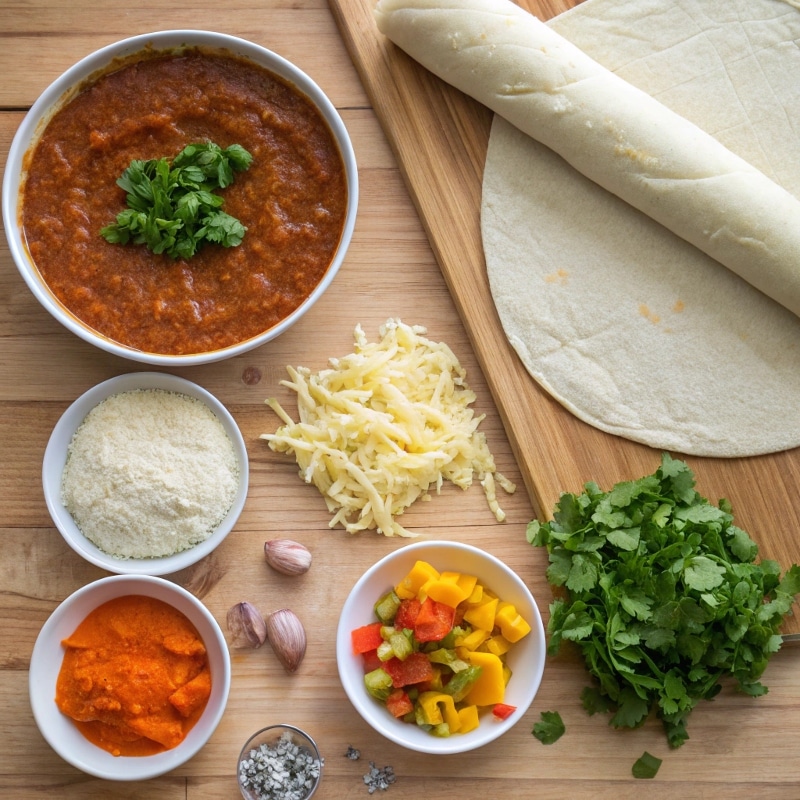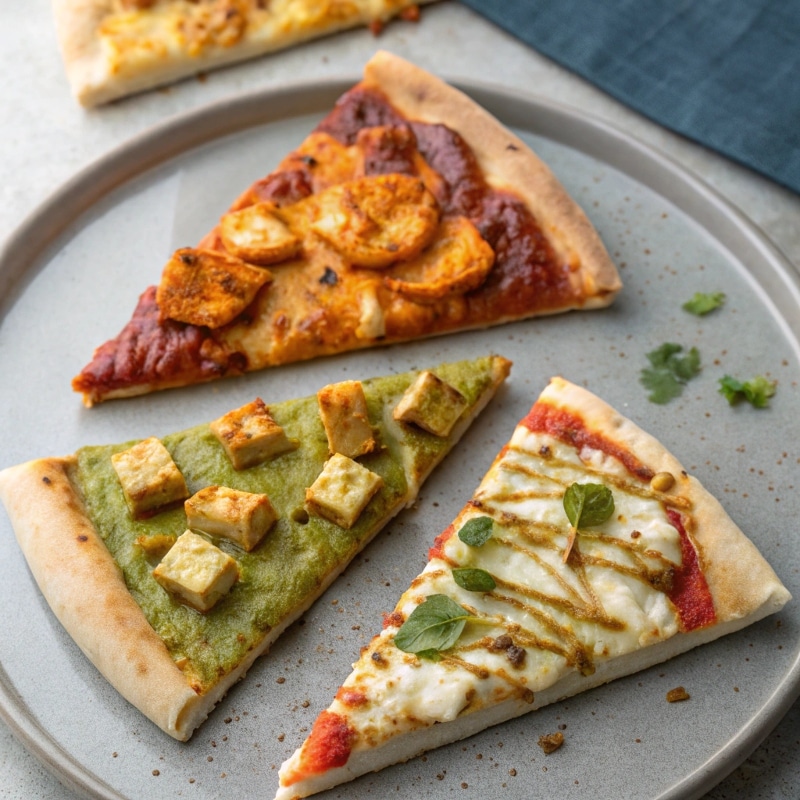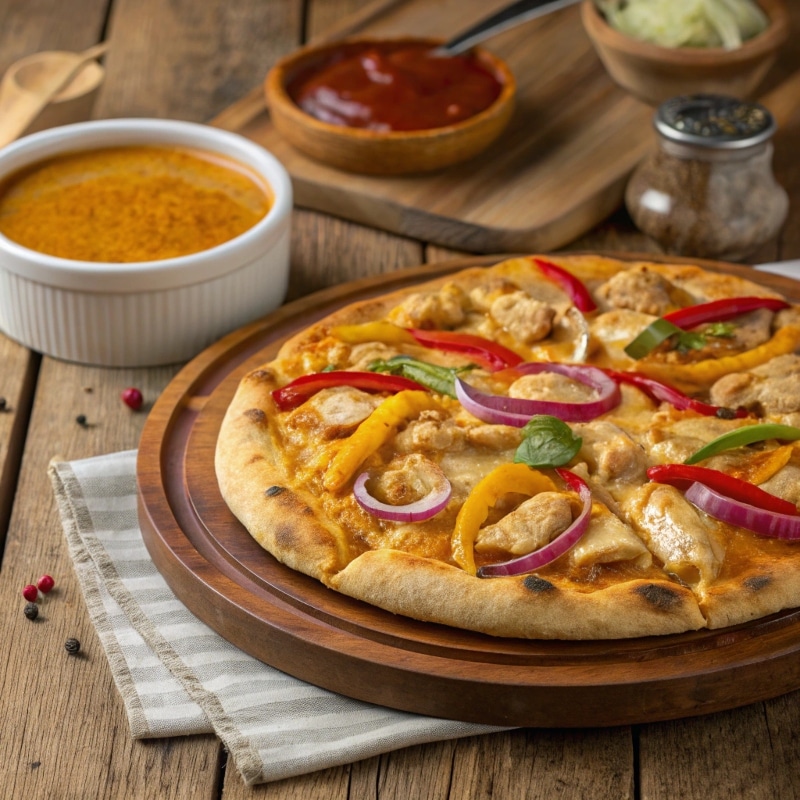Curry pizza is an exciting culinary innovation that blends the robust, aromatic flavors of curry with the universal appeal of pizza. This delightful fusion combines two beloved foods from distinct culinary traditions South Asian cuisine and Italian pizza-making to create a dish that’s truly unforgettable. But what makes curry pizza stand out, and why is it becoming so popular in both home kitchens and restaurants?
This guide dives into the origins, recipes, variations, and cultural significance of curry pizza, giving you all the tools you need to appreciate or even make this dish yourself. Whether you’re a fan of bold spices, curious about fusion cuisine, or simply looking for a unique take on pizza, this article will leave you informed and inspired.
Table of Contents
Print Recipe
Curry Pizza
Equipment
- Pizza Stone or Baking Sheet
- Mixing bowls
- Small saucepan
- Rolling Pin
- Oven
Ingredients
Pizza Base
- 1 pizza dough store-bought or homemade (naan or flatbread also works)
Curry Sauce
- 1 cup curry sauce butter chicken, tikka masala, or Thai green curry
Toppings
- 1 cup mozzarella cheese shredded (or mix of cheeses like paneer or cheddar)
- 1 cup protein chicken, shrimp, lamb, or tofu
- 1 cup mixed vegetables bell peppers, onions, tomatoes, spinach, mushrooms
Finishing Touches
- fresh cilantro or mint for garnish
- garam masala optional sprinkle for flavor
Instructions
- Preheat oven to 450°F (230°C) and line a pizza stone or baking sheet with parchment paper.
- Prepare the curry sauce: In a small saucepan, simmer garlic, ginger, onions, tomatoes, and spices (turmeric, cumin, coriander, chili powder) until thick and flavorful. Alternatively, use store-bought curry sauce.
- Ensure the sauce is thick enough to spread without making the dough soggy. Let it cool slightly before using.
- Roll out the pizza dough (or use naan) and spread the curry sauce evenly over the base.
- Add cheese, protein of choice (chicken, shrimp, tofu, etc.), and vegetables evenly over the pizza.
- Bake for 12–15 minutes, or until the crust is golden and the cheese is melted and bubbly.
- Top with fresh herbs, a sprinkle of garam masala, and serve hot.
Notes
Why Curry Pizza Is Unique
Blend of Spices and Flavors
Curry pizza stands out because of its bold and aromatic spices, which create a flavor experience that traditional pizza often lacks. The use of curry sauce instead of tomato sauce introduces a rich, savory base, while toppings like marinated chicken, paneer, bell peppers, or cilantro enhance the dish’s complexity. Each bite is a symphony of textures and tastes, ranging from creamy to crispy and spicy to tangy.
How Curry Complements Pizza Toppings
The versatility of curry allows it to complement a wide variety of toppings. For instance, a creamy butter chicken curry pairs perfectly with mozzarella cheese and a thin crust, while a spicy Thai green curry can be elevated with fresh vegetables and tofu. The key is balancing the flavors so that the curry does not overpower the other ingredients, creating a harmonious fusion of taste and texture.
Regional Adaptations of Curry Pizza
Curry pizza has evolved differently in various parts of the world. In India, it often features paneer, tikka masala, and naan bread as the base instead of traditional pizza dough. In Thailand, coconut milk-based curries and seafood are popular additions. Meanwhile, in Western countries, chefs experiment with different types of cheeses, crusts, and international curry flavors to cater to local tastes.
How to Make Curry Pizza at Home
Key Ingredients for Curry Pizza
Creating curry pizza at home is easier than you might think, and it all begins with the right ingredients. Here’s what you’ll need:
- Pizza Dough: Whether store-bought or homemade, pizza dough serves as the foundation. For an authentic touch, naan or flatbread can also be used.
- Curry Sauce: Choose a curry that suits your taste—options include creamy butter chicken sauce, spicy tikka masala, or coconut-based Thai green curry.
- Cheese: Mozzarella is the go-to for a classic pizza feel, but you can experiment with other cheeses like paneer, cheddar, or a mix for added flavor.
- Protein: Popular options include marinated chicken, lamb, shrimp, or tofu for a vegetarian option.
- Vegetables: Fresh vegetables like bell peppers, onions, tomatoes, spinach, and mushrooms provide crunch and flavor.
- Herbs and Spices: Fresh cilantro, mint, or a sprinkle of garam masala can add a burst of flavor.

Steps to Prepare Curry Sauce for Pizza
The curry sauce is the heart of a great curry pizza. Here’s how to prepare it:
- Choose Your Base: Start with a premade curry or prepare one from scratch using ingredients like garlic, ginger, onions, tomatoes, and spices (turmeric, cumin, coriander, and chili powder).
- Simmer for Depth: Allow the curry to simmer until the flavors meld together, creating a thick and flavorful sauce.
- Adjust for Consistency: Since it will replace tomato sauce on the pizza, make sure the curry sauce is thick enough to spread evenly without making the dough soggy.
- Cool Before Use: Let the curry cool slightly before spreading it on the dough to prevent it from absorbing too quickly.
Choosing the Perfect Toppings
When it comes to toppings, balance is key. Here are some popular combinations:
- Butter Chicken Pizza: Spread butter chicken curry as the base, add shredded chicken, red onions, and mozzarella, then finish with fresh cilantro.
- Paneer Tikka Pizza: Use tikka masala curry, top with cubed paneer, diced bell peppers, and red chili flakes for a vegetarian twist.
- Thai Green Curry Pizza: Start with a green curry sauce, add shrimp or tofu, julienned carrots, and fresh basil leaves for a vibrant, Southeast Asian-inspired dish.
Baking Tips for Curry Pizza
- Preheat the Oven: Set your oven to 450°F (232°C) for a crisp crust.
- Par-Bake the Dough: If using a thick crust, pre-bake it for 5-7 minutes to prevent sogginess from the curry sauce.
- Layer Thoughtfully: Spread the curry sauce evenly, add cheese next, and finish with toppings to ensure even cooking.
- Bake to Perfection: Place the pizza on a hot pizza stone or baking sheet and bake for 10-12 minutes until the crust is golden and the cheese is bubbling.
- Garnish for Freshness: After baking, garnish with fresh cilantro, a drizzle of yogurt, or lime juice for added brightness.
Top Curry Pizza Variations
1- Indian-Inspired Curry Pizzas
Indian cuisine provides a wealth of flavors and ingredients that pair beautifully with pizza. Here are some of the most popular variations:
- Butter Chicken Pizza: This variation combines creamy butter chicken curry with shredded chicken, red onions, and mozzarella cheese. The rich sauce acts as the perfect base, while the tender chicken adds protein.
- Paneer Tikka Pizza: A vegetarian favorite, this pizza uses marinated paneer (Indian cottage cheese) with tikka masala sauce, bell peppers, and a sprinkle of fresh cilantro. It’s hearty, spicy, and packed with flavor.
- Rogan Josh Lamb Pizza: For meat lovers, this pizza features the robust flavors of Rogan Josh curry with slow-cooked lamb, onions, and fresh mint.
2- Thai Green Curry Pizza
For a Southeast Asian twist, Thai green curry pizza offers a lighter yet equally flavorful option.
- Base: The green curry sauce, made with coconut milk, lemongrass, and green chilies, is creamy and aromatic.
- Toppings: Popular toppings include shrimp, tofu, or chicken, along with fresh vegetables like carrots, zucchini, and bell peppers.
- Finish: Garnish with fresh Thai basil or a squeeze of lime to enhance the flavors further.
3- Vegan and Vegetarian Options
Curry pizza is incredibly versatile, making it easy to adapt for plant-based diets. Here are some delicious options:
- Vegetable Korma Pizza: Use a mild vegetable korma curry sauce as the base, topped with roasted vegetables like eggplant, cauliflower, and bell peppers. Sprinkle with vegan cheese or nutritional yeast.
- Chickpea and Spinach Pizza: A spicy tikka masala sauce combined with chickpeas, fresh spinach, and vegan mozzarella creates a filling and nutritious pizza.
- Coconut Curry Pizza: This variation uses a creamy coconut curry base and is topped with tofu, broccoli, and red onions for a sweet and savory mix.
4- Global Fusion Curry Pizzas
Beyond Indian and Thai influences, curry pizza has inspired global adaptations:
- Japanese Curry Pizza: Sweet and savory Japanese curry serves as the base, paired with toppings like thinly sliced pork, potatoes, and carrots.
- Jamaican Curry Pizza: A Caribbean-inspired version with a bold, spicy curry sauce, jerk chicken, and pineapple for a tropical flair.
- Middle Eastern Curry Pizza: This version incorporates curry flavors with falafel, hummus, and a drizzle of tahini for a Mediterranean twist.

Nutritional Value of Curry Pizza
- Calories: The calorie count varies depending on the type of crust, curry sauce, and toppings. On average, a slice of curry pizza contains between 200 and 350 calories.
- Protein: With ingredients like chicken, paneer, tofu, or shrimp, curry pizza offers a decent amount of protein, ranging from 10 to 15 grams per slice.
- Carbohydrates: The crust and curry sauce are the primary sources of carbs, providing energy. A standard slice contains about 20 to 30 grams of carbohydrates.
- Fats: Cheese and curry sauce contribute to the fat content, which typically ranges from 8 to 12 grams per slice. Opt for low-fat cheeses or reduce the amount of cheese to make it lighter.
- Vitamins and Minerals: Curry spices like turmeric, cumin, and coriander are rich in antioxidants and anti-inflammatory properties. Fresh vegetables add vitamins A, C, and fiber, making curry pizza more nutritious than a standard pizza.
Frequently Asked Questions (FAQs)
What types of curry are used in this pizza?
Popular curry options include butter chicken, tikka masala, Thai green curry, and Japanese curry, depending on the regional twist of the dish.
Can I make it vegetarian or vegan?
Absolutely! You can use plant-based curry sauces, substitute paneer or tofu for protein, and use vegan cheese to make a delicious vegan-friendly curry pizza.
Is curry pizza spicy?
The level of spice depends on the type of curry sauce used. You can choose mild curries like korma for a milder flavor or spicier options like vindaloo for a heat-packed experience.
What are the best toppings?
Great toppings include marinated chicken, paneer, tofu, bell peppers, red onions, spinach, and cilantro. Choose toppings that complement the curry base for the best results.
Conclusion
Curry pizza is the ultimate example of how fusion cuisine can elevate the ordinary to the extraordinary. By combining the familiar textures of pizza with the vibrant, bold flavors of curry, this dish offers an unforgettable experience for your taste buds. Whether you try it at a restaurant or make your own version at home, curry pizza is sure to become a favorite for anyone who loves adventurous and creative food.
So, why not give curry pizza a try? Experiment with different sauces, toppings, and crusts to make a unique version that suits your taste. With its rich history, diverse variations, and endless possibilities, curry pizza deserves a spot on your plate today.
For more Recipes to Try
Looking for citrus-inspired desserts? Check out this recipe:
- Chocolate Orange Cake Recipe: Explore a richer take on orange desserts by combining chocolate and orange for a sophisticated treat.
Follow Kenz Recipes on Facebook for more delicious ideas, behind-the-scenes baking, and quick meal tips.


